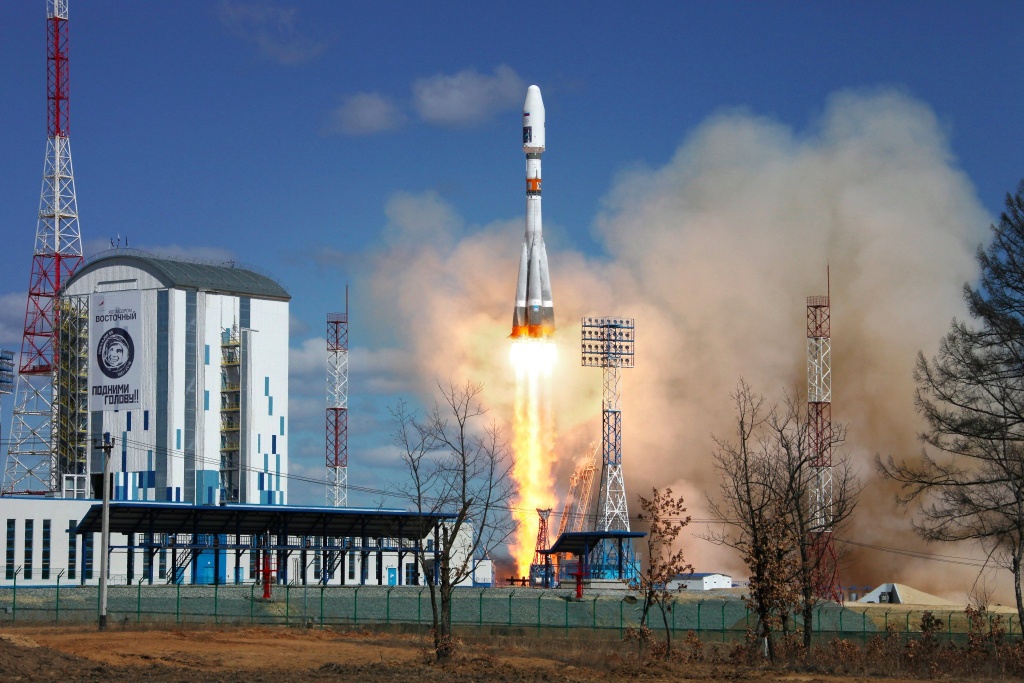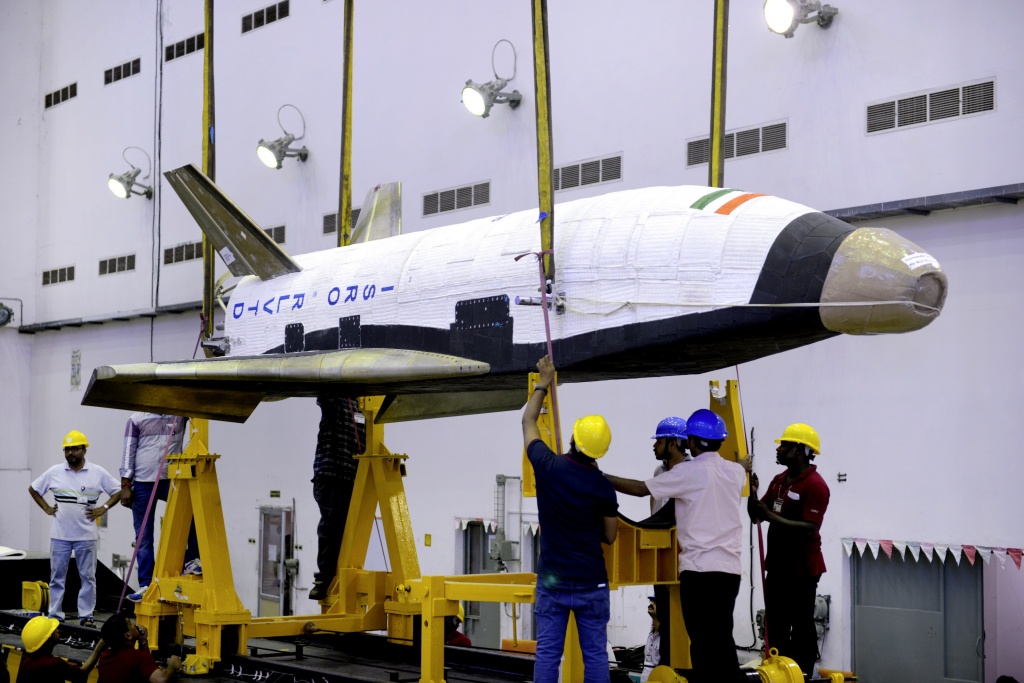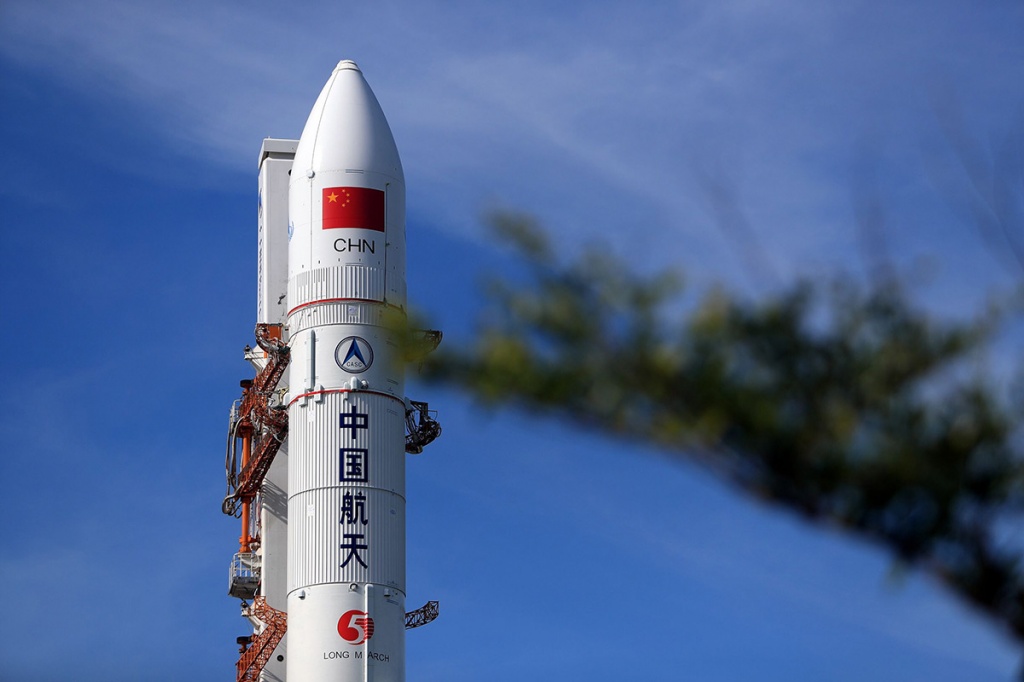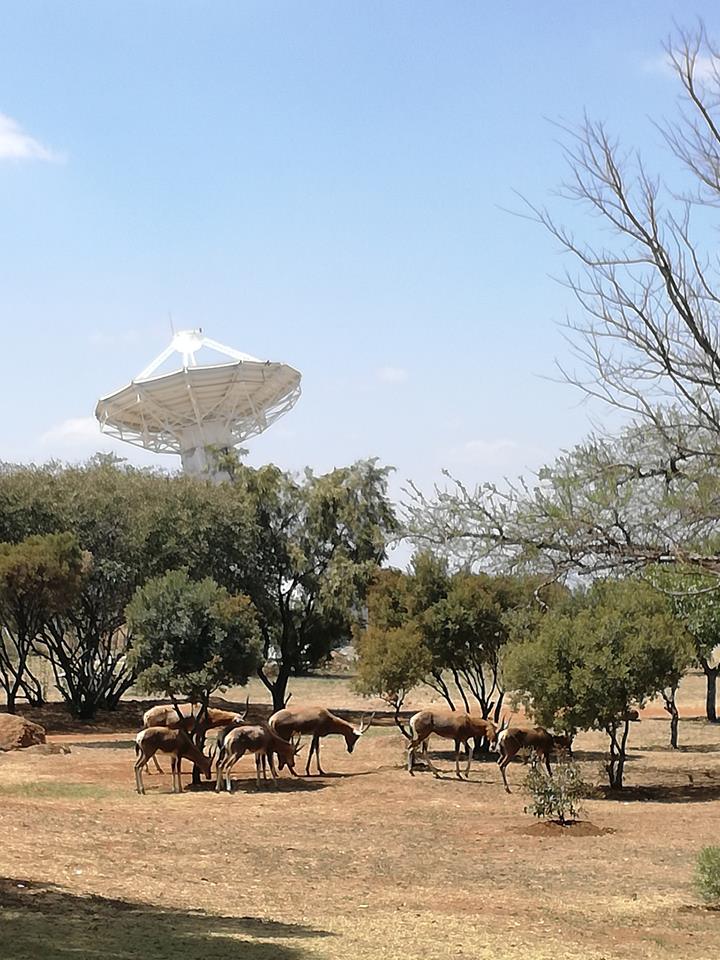Space Platform for BRICS Cooperation
Soyuz rocket with Glonass Navigation Satellite
In
Login if you are already registered
(votes: 17, rating: 4.82) |
(17 votes) |
Russian International Affairs Council Expert, Member of Space Generation Advisory Council
Not so long ago BRICS countries proclaimed the idea of creating an informal block that would serve as an alternative to already existing institutions of the global governance system. And it did not take long before “the bricks” started to work out — multidimensional cooperation took place. To expand the progress, BRICS may apply to outer space as one of the platforms of mutual interest.
Brazil strives for developing space technology in order to raise the quality of society’s life, implement efficient public policies and confront national problems in the spheres of meteorology, communications and a number of “Earth observation” questions.
Russia’s current period of dealing with issues of outer space can be described as “resurrection” — an association that deservedly comes up to the minds of experts when they analyze the “freefall” Russia right after the collapse of the USSR.
The first and prior goals of the Indian space program are to preserve Common Heritage of Mankind (through unambiguous support for the points of the Moon Treaty) and to use space groundwork for the sake of domestic interests. Following these goals India almost managed to catch up with notable successes achieved by the locomotives of the first space race — the Soviet Union and the United States of America.
The immensity and diversity of efforts mounted by the PRC also led to China becoming the third nation to achieve manned space travel: China sent its first astronaut into space in 2003, then making a first space walk in 2008 (with astronauts aboard Shenzhou-7).
South Africa is committed to utilize outer space for the peaceful purposes and welfare of the whole humankind. It wants to benefit from entering global aerospace supply chains, participating in knowledge-economy, resorting to space-related products of the “common space”.
All five BRICS countries have already beeninvolved in exploration of outer space regardless of the goals pursued. Though
usually the latter do interlace at the point of willingness to use modern
technologies to secure sovereignty and be able to struggle against either
anthropologically or naturally caused problems. In addition, being regional
leaders members of BRICS reckon on new achievements to fortify their leadership
and in such a way justify their high ambitions to re-construct the world order
and add new poles to the present system of distributing power.
Not so long ago BRICS countries proclaimed the idea of creating an informal block that would serve as an alternative to already existing institutions of the global governance system. And it did not take long before “the bricks” started to work out — multidimensional cooperation took place. To expand the progress, BRICS may apply to outer space as one of the platforms of mutual interest. Like in the case of struggling against the bipolar order of the Cold War in political and economic contexts, now the BRICS nations are able to confront the imperfect system of regulating space. It is believed that since 2003-2004 the world has stepped into the era of the “second space race” which marks high time for the members of BRICS to achieve their top ambitions. [1]
BRICS Leaders Xiamen Declaration 2017 supports the statement raising the issue of peaceful and secured outer space in points 26, 58, 59. For us to assess feasibility of these provisions it is necessary to check whether the BRICS member-states have a firm ground regarding the level of space exploration or not, whether they have sufficient space assets to jointly stand for a multipolar world or lack them. Description of national space programs of the BRICS countries given below is to enhance better understanding.
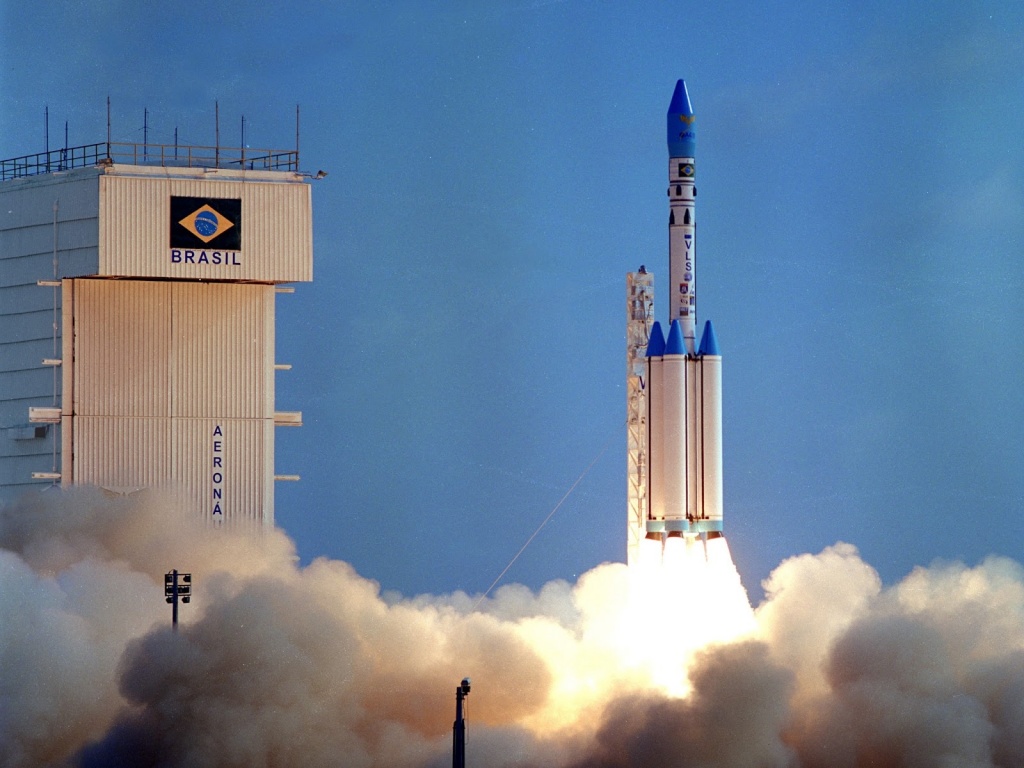
The Brazilian Space Agency has been working on the development of a VLS or expendable satellite launch vehicle since the 1984. There have been three launch attempts between 1997 to 2003, all resulting in failure with the last (VLS-1 V03) taking the lives of 21 personnel when it exploded while on the launch pad after one of its four Solid Rocket Boosters (SRBs) was accidentally ignited
Brazil
Brazil may be said to have started positioning itself as a spacefaring nation in 1961 when its government, being supported by the USA, first initiated the program of space exploration and organized the special National commission, successfully transformed into National Institute for Space Research (INPE) in 1971.
The 1960s marked a “golden age” for Brazil: rocketry and space exploration firmly occupied a certain niche in the development and strategic planning of the state due to the country’s geography. The size of the country, its prolonged coastline, tropical regions, extensive natural resources as well as the fact of being crossed by the equator-line (letting it take additional advantage of the Earth’s spin such as fuel savings and cheaper launches) [2] enhance chances of realizing national ambitions with the help of space technologies. NASA benefited from this peculiarity till 1977 when the state launched its own rocket program undermining dependence on cooperation with the American state. [3]
Since creation of the Brazilian Space Agency (AEB, 1994) the country stimulated independent outer space research through fostered cooperation between institutions comprising the so called National System for the Development of Space Activities (SINDAE) [4]. Brazil also set up partnership with the International Space Agency while focusing on maintenance of test facilities, control centers, research laboratories. Ground stations laid the foundation for further improvement and supplementation of the national space program.
Today AEB has several active imagery intelligence satellites in orbit, including reconnaissance and earth observation satellites and develops those to provide low cost communications around the equator. In 2004 Brazil successfully launched its first rocket into space.
Strategic goals set by the country are described in the National Program of Space Activities 2012–2021 (PNAE 2012–2021). Brazil strives for developing space technology in order to raise the quality of society’s life, implement efficient public policies and confront national problems in the spheres of meteorology, communications and a number of “Earth observation” questions. Space activities stimulate innovation that will consequently influence industry and citizens, while mutual cooperation is seen as the instrument of promoting advancement.
Russia
Russia’s current period of dealing with issues of outer space can be described as “resurrection” — an association that deservedly comes up to the minds of experts when they analyze the “freefall” Russia right after the collapse of the USSR. The very split of an earlier powerful “machine” had a tremendous impact on the branch. On the one hand, it was caused by the necessity to adjust to new rules of “managing business” (during the Soviet years there were no central executive agencies — therefore, a task of organizing an own institution from scratch was posed) [5] ; on the other hand, the conditions for retaining a clear lead in space were intertwined with financial problems — the most reliable way to keep afloat was to launch commercial satellites and engage in space tourism (profitable but lacking opportunities for self-development).
This unfortunate position could hardly be heartily welcomed after a giant leap forward during the first space race with the USA. The former Soviet Union sweepingly burst through difficulties on its way using intellectual and material potential possessed. In the late 19th and early 20th centuries a pioneer of space exploration Konstantin Tsiolkovsky shared his concept of the future of multistaged rocketry. His followers made his theoretical developments come true to life. From then on the country served as the locomotive of technological advancements, the most notable of them being first launched satellite (1957), first probe to impact the Moon (1959), first man in space (1961) and a number of other “firsts”.
Crisis years, in particular, early 1990-s, prevented Russia from following the rising trend. Although already up to 2005-2006 it felt more determined to recur putting an additional accent (plus spending) on the new Angara rocket family (along with the Soviet-designed Soyuz) and the GLONASS global navigation satellite system. Meanwhile it continued to be one of the main partners in the International Space Station program to deliver expedition crews and to resupply the space station with its transporters. It owns a series of diverse satellites for commercial use but still faces a lack of capacity to ensure development of national scientific cosmonautics.
Hitches with launching an unmanned Soyuz-2.1 a rocket from the recently-constructed Vostochny cosmodrome as well as the failure to launch the Phobos-Grunt probe in 2011 undermine the trend of Russia following “the lucky path”. Sanctions pressing the country somehow aggravate the situation, making the matters worse by causing cuts in funding of the 10-year space program. [6]
Whatever the case, the political will and persistence are likely to overcome these troubles and let Russia fulfill the plan of conducting a full-scale lunar program up to 2025 and landing a man on the Moon by 2030. Amid the country’s broad space background and capacity for possessing all the space technologies known by the time, it makes Russia alluring as the potential “teacher” for space “newcomers”.
India
The first and prior goals of the Indian space program are to preserve Common Heritage of Mankind (through unambiguous support for the points of the Moon Treaty) [7] and to use space groundwork for the sake of domestic interests. Following these goals India almost managed to catch up with notable successes achieved by the locomotives of the first space race — the Soviet Union and the United States of America.
First, the Indian Space Research Organization (ISRO) started to elaborate its program as applications-oriented (in cooperation with the USSR). Multipurpose satellites aimed at providing telecommunications, remote sensing, ground operations and meteorological payloads were a key focus for almost four decades. Then the country determined to draw a more precise attention to dedicated scientific satellite missions. As a result, its Mars orbiter mission called Mangalyaan undertaken in 2014 made the world look at the country from the new lens.
Before this emerging trend India successively conquered the following heights of space exploration. In 1975 India launched its first satellite called Aryabhata with the purpose of gaining experience in building and operating a satellite in space. In 2008 the country carried out its first lunar mission encouraged by the opportunity of utilizing extra-terrestrial resources. Though to some extent dependent on the US support the Mars Orbiter Mission (2014) was successfully deployed. Despite the fact that it was criticized for inability to deliver more payloads, the Mangalyaan spacecraft made India the 1st Asian country to reach Mars and the 4th one (after the US, Russia, the European Space Agency) to land on the Red Planet in general. The probe, devised thanks to cooperation between ISRO (responsible for launch vehicle, payloads and the craft) and separate industries/ scientific community (to work on separate needs for serving the launch), demonstrated a well-functioning mechanism of public-private partnership. It is also noteworthy that the launch was a really “high-profile venture”: it came at a very low cost. The mission was admitted to be the least expensive inter-planetary one ever, thus, laying the ground for positioning India as the competitive provider of low-cost services. India attracts other actors to participate in the process of enhancing its capabilities: France to jointly launch heavy-payload satellites; Israel to improve parameters of reconnaissance satellites. In 2016 India launched its reusable launch vehicle (RLV-TD) enabling deeper analysis of autonomous navigation, hypersonic speed and the re-entry process to resort to in future decades.
Prospects for development include realization of the human spaceflight program; increasing the number of flights to the geostationary orbit [8], satellite launch facilities, lunar and other missions and development of reusable vehicles.
China
Beijing is obviously one of the most passionate investigators advancing interests in the outer space. In the interview to CNBC James Andrew Lewis, a senior fellow and director of the Strategic Technologies Program at the Center for Strategic and International Studies, said that the Chinese demonstrate that sort of persistence that would allow them get to the Moon earlier than the Americans will during the ongoing space race. We may assume that this refers to the whole list of projects declared by the China National Space Administration [9] involving establishment of a national crewed space station, landing a rover on the far side of the moon around 2018, launch of the first Mars probe by 2020, and construction of space-based solar power station reiterated by Lt. General Zhang Yulin, deputy chief of the Armament Development Department of the Central Military Commission, in 2016.
Right after the Sino-Soviet split China submerged into deploying a full-fledged space program to have ever-lasting consequences. Before moving to the “S&T” priority (like India) China set a prominent margin: today it possesses four space launch facilities (Jiuquan, Taiyuan, Xichang) and Wenchang Satellite Launch Centrefinally constructed on Hainan Island in 2016 — these serving as the bases for launching satellites into all-level orbits (low, middle, geosynchronous) while benefiting from having completely Chinese-manufactured Long March family of launch vehicles. A range of satellites is extensive. Chinese satellites today span the gamut [10] from weather (Fengyun) and navigation platforms (Beidou/Compass system) to earth observation and reconnaissance satellites (Ziyuan, a product of CBERS), from civil and military communications satellites (Shentong and Fenghuo) to an array of small satellites. The mentioned Beidou system made China the third country to arrange transmission of the user’s location.
The immensity and diversity of efforts mounted by the PRC also led to China becoming the third nation to achieve manned space travel: China sent its first astronaut into space in 2003, then making a first space walk in 2008 (with astronauts aboard Shenzhou-7). In late 2013 the state completed the first since 1976 “lunar soft landing” with the Chang'e-3 craft and its Jade Rabbit rover. In 2014 it sent a probe around the Moon — the first such mission since the 1970s.
Consecutive and dynamic development of the country’s space program leaves no doubt that China is a leading spacefaring nation today. And though spending 4 times less (OECD, 2013) than NASA on its technological perfection it seems to be able to cut this gap: whether it be a plan for a manned space station to be built up to 2020 (an urgent need for the country that was barred from participating in the International Space Station and already demonstrated a capability of docking — the basics for maintaining a station) a manned mission to the Moon by 2030 or (un)crewed Mars exploration (2015-2060).
Enumerated ambitious projects cannot but cause debates in the international arena. While the USA blames China for growing not only peaceful but counterspace investments [11], China continues to push the boundaries of innovation and, nonetheless, gets offers to fortify US-China-EU Strategic Space Partnership by creating a space development investment bank or launching a joint Mars investigation program.
To sum up, China has proved to have a considerable positive experience on the agenda and is free to choose its either cooperative or independent path — anyway, it is able to contribute internationally while pursuing an explicit political goal of “the great revival of the Chinese nation”.
South Africa
The period of 1963-1993 laid the basis for initiating the state’s own space program. [12] Since 1980 the South African Government has worked on the space launcher and eventually managed to build test range infrastructure which let conduct its test firing of the first stage in 1989. After 1994 South Africa established a range of scientific centers to let academia (along with industry representatives) contribute to the “advancement of space arena” (Council for Scientific and Industrial Research, The Institute of Satellite and Software Applications, The Overberg Test Range, The South African Air Force’s Test Flight and Development Centre) to develop its independent space program. It signed up all the documents comprising the “space constitution”. [13] In 1999 it launched its first satellite Sunsat-1 Vandenberg Air Force Base, which successfully operated then during two years in the low earth orbit and resulted in creation of the company with the same name. The second satellite (SumbandilaSat) was launched in 2009 from the Baikonur Cosmodrome in Kazakhstan. The launch was carried out as a part of of a three-year program aimed at completing a full-aspect space mission, though its main merit is more referred to investing in human capital in scientific, regulatory and policy spheres rather than simply a technical one.
The future goals proclaimed in the National space strategy make us aware of ambitious points set by the country as prior: it strives for having a fully established space program with full-range space application services and products to be resorted to by both local and international users. This involves manufacturing satellite sensors and data processing, carrying out Earth observation, these working for priority areas such as food security, disaster management and land-cover mapping.
What else does South Africa care about when developing a new segment of activities? The national space policy launched in 2009 put it clear: South Africa is committed to utilize outer space for the peaceful purposes and welfare of the whole humankind. It wants to benefit from entering global aerospace supply chains, participating in knowledge-economy, resorting to space-related products of the “common space”.
All in all, existing infrastructure of the country and experience gained along with profound workforce allow South Africa to designate itself as the regional hub of space science and technology which may be used in the context of strengthening ties with space-faring nations.
Cooperation between the five in space sphere
Unfortunately, at the moment the cooperation of five states in outer space is not too active. The countries are rather examining each other’s capabilities in order to formulate the future logic of forging ties, doing this against the background of proclamations voiced during Summits and then recorded in the final Declarations.
The BRICS leaders express willingness [14] to prevent arms race in space and renew negotiations on non-deployment of weapons and non-militarization. The BRICS representatives stand for peaceful joint activities connected with the effective common use of space technologies. Since the mid-2000s Russia and China have persistently sought for devising confidence-building measures in outer space to provide collective security and prevent space militarization/weaponization and presented their position during the UN sessions.[1] The most determined attempts to persuade the UN members in the necessity to regulate space activities were demonstrated in 2000 and 2005 (when the Russian delegation offered a draft document providing “collective security” in space and prohibiting deployment of conventional weapons in space). These endeavors were repeated in 2007 when Russia and China simultaneously suggested concluding a new agreement on space non-militarization. But political motives of the USA didn’t let the world community accept any of the drafts that would imply obligatory implementation. However, today the balance of powers is shifting which means the BRICS nations may lobby their interests louder and achieve global goals.
But proclamations shall be supplemented by something ponderable — real cooperation. By now the list of common projects is as follows:
1. Russia’s Global Navigation Satellite System has a ground control station in Brasilia (Brazil) while Brazil is currently developing the second launcher family with the help of Russian partners.
2. In 1988 China and Brazil concluded an agreement on cooperation in S&T sphere followed by initiating China Brazil Earth Resources Satellite (CBERS) program — a long-term driver of joint cooperation. Remote sensing satellites are a prerogative of bilateral collaboration. Images generated by CBERS satellites are used in such areas as deforestation control and environmental monitoring, water resources monitoring, urban growth, soil occupation, education and other applications.
3. In 2011 Russia and India launched a scientific-educational satellite called YouthSat to study solar flares and their influence on the Earth.
4. The IBSA trilateral alliance (India, Brazil, South Africa), formalized in 2003, stands for reciprocal exchange of knowledge in S&T sphere in space domain.
5. Surprisingly, in this “adult” realm youth dimension has its voice: in the wake of the first Youth BRICS Summit (2015) Ministers of the Youth Affairs suggested creating a common space station (that would be required after expiration of ISS operating time in 2024), taking into account debates provoked by young delegates.
Sino-Russian relations deserve an additional remark. The Chinese boost in the 1990-s depended largely on the Russian sponsorship and technologies. The intergovernmental agreement on scientific cooperation and peaceful use of outer space concluded in 1992 paved the way for 93 deals including traineeships for taikonauts (the Chinese cosmonauts) in the Russian center named after Yury Gagarin. As soon as sanctions on Russia were imposed in 2014 negotiations between the countries got a new breath: Russia had to search for someone to replace American supplies of electronic components used in build-up of satellites. China came to the fore. Balance of interests was found and states started complementing each other’s space programs (Russia provides engines for acquiring micro radio electronics).
Thus, all five BRICS countries have already been involved in exploration of outer space regardless of the goals pursued. Though usually the latter do interlace at the point of willingness to use modern technologies to secure sovereignty and be able to struggle against either anthropologically or naturally caused problems. In addition, being regional leaders members of BRICS reckon on new achievements to fortify their leadership and in such a way justify their high ambitions to re-construct the world order and add new poles to the present system of distributing power. It becomes even more desirable and probable due to the calculations showing that Russia, India and China carried out 62% of the latest orbiter launches.
It is to be admitted that there is a sharp difference in the history (duration, directions) of space programs of the BRICS members. Nonetheless, it shall not be a hindrance to overcome — it may be apprehended as the time to recognize advantages and use them to their best interests (keeping in mind the “complementarity principle”). It applies to geographical characteristics, established infrastructure, volume of scientific research, practices in public-private partnership — everything that may help to reduce the time for going through all the stages of undertaking space missions. It is sensible to work out co-ordinate strategies to prevent duplication of space technologies and concentrate resources on dealing with fundamentally urgent problems and, eventually, winning outright. Expressed readiness for multilateral cooperation is an advantage.
Notes
1. Bogaturov Alexey. Mezhdunarodnye Otnosheniia Rossii V "Novykh Politicheskikh Prostranstvakh" (Moskva: Lenand, 2011), pp. 148-161.
2. This makes launches of geostationary satellites more attractive.
3. Negotiations on the probable rapprochement with the US resumed several times, once ending in an agreement to exchange access to American launchers for the access to the Alcantara Launch Center on the northeastern coast, in the state of Maranhao; though this “attack” against Brazilian territorial sovereignty is strongly denounced by society.
4. SINDAE includes INPE, responsible for development of satellites and relevant technologies in the context of Earth Observation and Space Applications, IAE (the Institute of Aeronautics and Space) dealing with issues of launching satellites and sounding rockets (meanwhile servicing the Alcântara Launch Center (CLA), and the Barreira do Inferno Launch Center).
5. Now it is Roscomos State Corporation for Space Activities that is responsible for space science in Russia. Was previously known as the Russian Aviation and Space Agency.
6. It was initially planned to spend 3.4 trillion rubles ($70 billion), then cancelled for 1.4 trillion rubles ($20.5 billion).
7. The Moon Treaty (1979) followed its predecessor, in particular, the Outer Space Treaty (1967), and envisaged the ban on private ownership of extraterrestrial property and promoted creation of a common international regime to control allocation of resources. Was signed and ratified by a limited number of states.
8. Rather than flights the LEO on the Polar Space Launch Vehicles (PSLV).
9. CNSA is the national space agency of China. It is responsible for the national space program and for planning and development of space activities.
10. Kosmicheskaya deyatelnost’ Kitaya / FGBU NTIMI. M: Moskva, 2013.
11. The test of a Chinese SC-19 direct-ascent anti-satellite (ASAT) in 2007 provoked both indignation and fears on the US behalf.
12. Keith Gottschalk. South Africa's Space Program. 2010. Astropolitics 8 (1): pp. 35-48. doi:10.1080/14777622.2010.496528.
13. The Outer Space Treaty (1967), Rescue Convention (1968), International Telecommunication Satellite Agreement (1971), Liability Convention (1972), Registration Convention (1975), International Mobile Satellite Organization (1976), and the International Telecommunication Convention (1992).
14. BRICS Joint Statement Regarding the Principles of Elaboration of International Instruments on Outer Spacе Activities, New York, July 27, 2015. URL http://www.mid.ru/en/foreign_policy/news/-/asset_publisher/cKNonkJE02Bw/content/id/1623220; BRICS Leaders Xiamen Declaration: Full text. 2017. URL http://timesofindia.indiatimes.com/india/brics-leaders-xiamen-declaration-full-text/articleshow/60359120.cms.
(votes: 17, rating: 4.82) |
(17 votes) |
Commercial Space Revolution
Will There Be New Star Wars in Asia-Pacific? China's Military Space Program Diplomacy in spaceFrom the Cold War to the International Space Station
BRICS: Will the Future be Brighter?This year the summit is unusual: it is held in the time when security agenda is brought to the forefront


